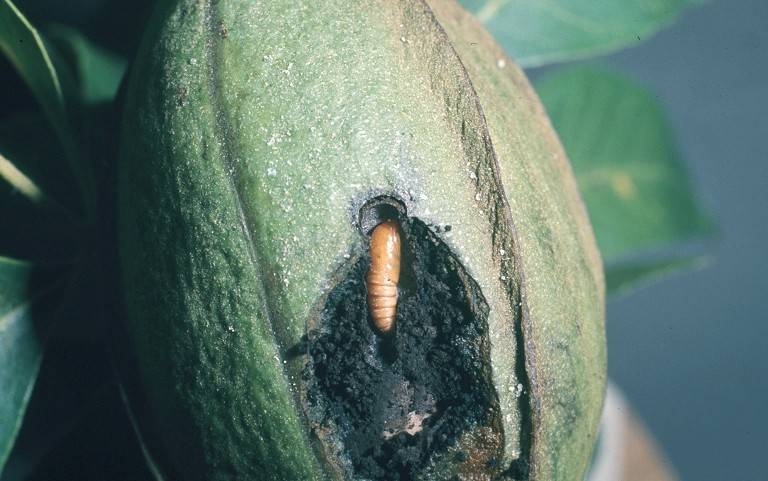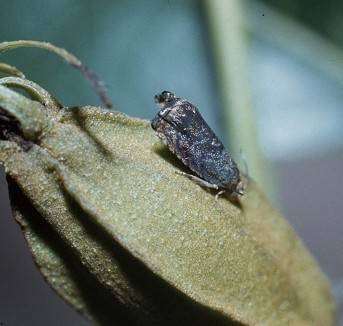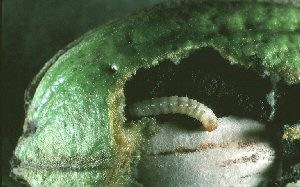Hickory Shuckworm
 Scientific Name
Scientific Name
Cydia caryana
Hosts
The primary hosts are pecan and hickory and the larvae feed mostly in the nut shucks, especially after shell hardening. The first generation larvae commonly feed and develop in phylloxera galls.
Symptoms
 First generation larvae may destroy a few pecan nutlets but this damage is usually
not heavy enough to be serious. Second generation larvae feed in the nuts causing
them to drop from the trees. Third generation larvae mine the shucks, reducing nut
fill and causing the shucks to adhere to the shell. This reduces nut quality and yield.
Damage to phylloxera galls can be considered _ beneficial; however, serious shuckworm
problems often follow a heavy infestation of phylloxera.
First generation larvae may destroy a few pecan nutlets but this damage is usually
not heavy enough to be serious. Second generation larvae feed in the nuts causing
them to drop from the trees. Third generation larvae mine the shucks, reducing nut
fill and causing the shucks to adhere to the shell. This reduces nut quality and yield.
Damage to phylloxera galls can be considered _ beneficial; however, serious shuckworm
problems often follow a heavy infestation of phylloxera.
Life Cycle
 Shuckworms overwinter as pupae in old pecan shucks on the tree or scattered about
on the orchard floor. Adults emerge from mid-April to mid-May, mate, and lay eggs.
First generation eggs may be laid on hickory nuts, small pecan nutlets, or phylloxera
galls. Larvae in pecan nutlets die when the nuts fall from the trees as the nuts are
to small to allow development. Larvae in hickory and phylloxera galls develop in May
and June and first generation adults emerge in late June and July. These adults lay
eggs on pecan nuts and cover them with a gelatin-like material produced by the female.
This material becomes creamy white and is a distinctive characteristic of shuckworm
egg sites. The larvae feed in the nuts during July and August. Nuts damaged by this
generation usually drop from the tree. Second generation adults emerge in late August
and early September and give rise to a third generation of larvae. They feed in the
pecan shucks during the fall, pupate, and overwinter. There are three generations
per year in Oklahoma.
Shuckworms overwinter as pupae in old pecan shucks on the tree or scattered about
on the orchard floor. Adults emerge from mid-April to mid-May, mate, and lay eggs.
First generation eggs may be laid on hickory nuts, small pecan nutlets, or phylloxera
galls. Larvae in pecan nutlets die when the nuts fall from the trees as the nuts are
to small to allow development. Larvae in hickory and phylloxera galls develop in May
and June and first generation adults emerge in late June and July. These adults lay
eggs on pecan nuts and cover them with a gelatin-like material produced by the female.
This material becomes creamy white and is a distinctive characteristic of shuckworm
egg sites. The larvae feed in the nuts during July and August. Nuts damaged by this
generation usually drop from the tree. Second generation adults emerge in late August
and early September and give rise to a third generation of larvae. They feed in the
pecan shucks during the fall, pupate, and overwinter. There are three generations
per year in Oklahoma.
Description
The adult is a small, dark brown to smoky black moth about 1/3 inch long. There is a series of dark and white marks on the outer edge of each front wing near the outer end. The larvae are white or cream colored with brown heads and are about 112 inch long at maturity.
Control
Please contact your local county extension office for current information.
